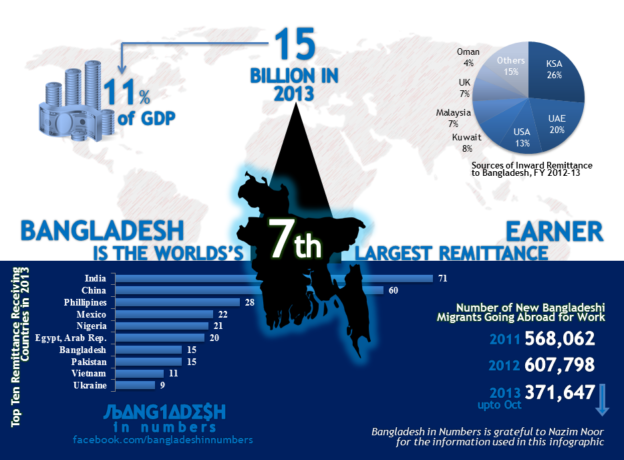GET IN TOUCH
- Please wait...

Credit: Bangladesh in Numbers
In 2008, when seemingly “invincible” economies became hostages of the global economic downturn, Bangladesh emerged as a dark-horse and rode the storm admirably. While the super powers barely managed to bring any economic growth (with some falling into recession), Bangladesh produced its trademark above-6% GDP growth rate. This should not raise any eyebrows. The economy is barely integrated with global trade. The only major trade it relies on is in basic RMG product which is relatively inelastic to downturns in global purchasing power. The economy benefits from low labour costs and a growing young population – a large portion of which works as overseas migrants and remits huge amounts of money every year. In FY 13 alone, RMG exports and overseas Remittance inflow totaled approximately USD 35.5 bn or around 30% of our GDP! If we look back for the past five years, RMG exports have grown at a CAGR of approximately 13% while remittance has grown at a CAGR of 12%.
It is evident that these twin-engines of Bangladesh have played an invaluable role in propelling our economy. Naturally, it is imperative that we ensure that these two economic drivers can sustain long-term growth if Bangladesh is to achieve middle-income status within 2021.
Are our dual-drivers safe?
In the current fiscal year, the story has been slightly different for our twin-engines. While exports have sustained 13% growth in the July-April period of 2014 compared to the same period of the previous year, remittance has experienced an alarming decline. After bringing in USD 14.5 bn in FY 13 with a 12.7% growth rate, Bangladesh was all set to see a USD 15 bn in remittance this year. But with a negative growth of 4.8% in the first 10 months of the fiscal year, that dream is all but shattered. It begs to question, what went wrong after around a decade of consecutive year-on-year growth.
The general consensus is two-fold. Firstly, Bangladesh is failing to send more workers abroad to traditional markets. According to Bangladesh Bank, around 450,000 migrants managed overseas jobs in 2013, down by more than 33% from 680,000 in 2012. Secondly, the number of migrant workers returning to Bangladesh has also increased because the government could not resolve the problems related to the legal status of Bangladeshi migrant labors in Saudi Arabia, the United Arab Emirates and Kuwait through diplomatic channels. These three destinations accounted for approximately 54% and 56% of our total remittance inflow for the last two years. It does not take a genius to identify that over-dependence on a few countries has brought about this disappointing performance in remittance this year. In other words, lack of diversification, in our manpower export destination, is the real root of this problem. With diversification turning out to be such a pivotal factor in growth of one of our core economic propellers, we need to understand if our other growth engine – RMG exports – runs the same risk or not.
According to Bangladesh Bank statistics, the United States, Germany and United Kingdom and France has accounted for around 40% of total RMG exports for much of the last five years. Here again, we have a situation where only four countries account for two-fifth of our RMG exports. Who is to say that the same lack of diversification which has hurt remittance this year will not do the same for RMG exports in the future? Barely a year ago, before data on falling manpower exports were available, economists, analysts and virtually everyone would have put all their money on remittance continuing its rapid rise. That is until a fundamental risk finally took its toll.
In a completely similar manner, such “shocks” may be seen in the RMG sector if proper diversification initiatives are not taken. Policies by major destinations discouraging our exports can cripple our biggest economic driver. A simple example would be loss of GSP facilities in the EU. While losing the same status in the United States has not hurt us, one cannot say our exports will remain strong if the same thing is to happen in the EU.
Diversification could be the Key to Sustainable growth
Therefore, it becomes imperative for the government, regulatory authorities and leading export houses to continually work together to find new export destinations and reduce risk on dependence on a few countries. It is high-time that we look at destinations like South America, several countries in Africa as well as Australia to export our RMG products. While one may argue that building substantial markets in such areas take considerable amount of time, the initiatives need to be taken at one point of time or the other; and it is always better to start sooner rather than later.
Similar initiatives need to be taken in order to revive remittance flows. Yes, certain initiatives have been taken since the disastrous slide started – the results of which are evident from marginally better remittance figures since February of 2014. But, to return to double-digit growth rates of the previous years, massive collaboration is needed between the government of Bangladesh and potential destinations for manpower export. The effort of course is necessary if the USD 14bn of virtually “cost-free” supply of income is to be protected.
For Bangladesh to meet its goal of rising to Middle-Income Status by 2021, steady growth of arguably its strongest economic drivers is a must. Any further disruption will push us back a long way. Thus it is imperative, that we do what it takes to make sure the future is bright for our economy’s twin-engines.
Our experts can help you solve your unique challenges
Stay up-to-date with our Thought Leadership and Insights